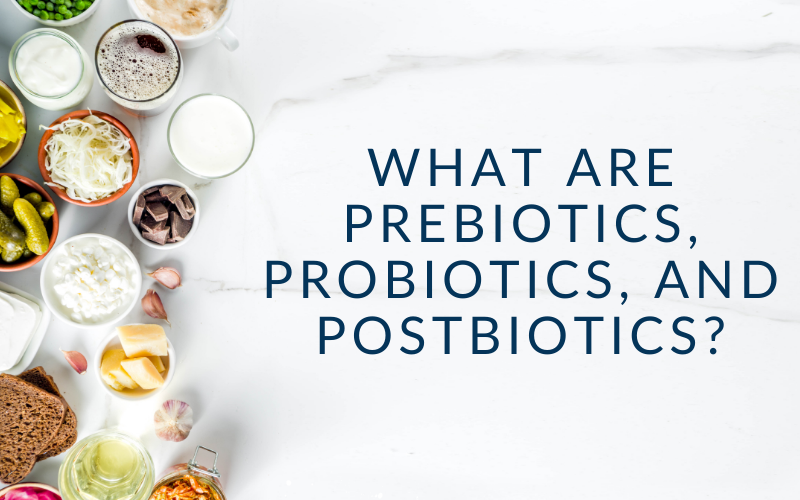Most of us are pretty familiar with probiotics. They line the shelves of every grocery store and drugstore and they are talked about widely. But what is the importance, really? And then maybe you’ve heard rumblings of prebiotics. Or prebiotics packaged with probiotics. And now there’s the concept of postbiotics.
It’s a lot to keep straight, so I thought I’d just do a quick breakdown so you can understand exactly what these things are, how they work in concert and why you should even care.
How it Works
We eat foods rich in prebiotics (like your asparagus with dinner last night), that asparagus travels down your gi tract, many of the nutrients are absorbed by your small intestine, and when it reaches your colon, the fiber left over that we can’t digest gets gobbled up by our gut microbiota, or probiotics. By eating these fibers, the probiotics create something called postbiotics. Postbiotics are the new frontier in gut health and we’re finding that they’re responsible for a large part of our health. The goal is to eat more pre and probiotics so that we can have lots of postbiotics to keep us feeling great.
Prebiotics
Prebiotic categories include:
- Breast milk oligosaccharides
- Conjugated Linoleic Acid (CLA)
- Oligosaccharides
- Plant polyphenols and phytonutrients
- Soluble fiber
How to Get Prebiotics:
Eat prebiotic-rich foods! Prebiotic supplements and supplements containing prebiotics have become trendy in recent years, and though it has been shown to be beneficial in some cases, there has been research that links supplemental prebiotic fiber with an increase in liver cancer in mice. This may be a reason for us to stick to food-based prebiotics like the following.
Some foods richest in prebiotic fibers:
- asparagus
- artichokes
- avocados
- cruciferous veggies
- berries
- green bananas
- chia seeds
- chicory
- cocoa
- dandelion greens
- dairy products containing CLA’s
- eggplant
- flax seeds
- fruit
- garlic
- green tea
- honey
- jicama
- leeks
- legumes
- lentils
- onions
- peas
- plantains
- potatoes
- radishes
- root veggies
- sea veggies
- spices and herbs
- tomatoes
Prebiotic-rich foods are also often highly-pigmented, containing these incredible phytochemical that act as antioxidants in our bodies. Without our gut microbes to activate these polyphenols, we are only capable of activating 5% of these ourselves.
Probiotics
Probiotics describe the trillions of microbes living in our gut – mostly our large intestine – that we rely on for giving us our vibrant health. These guys need us to feed them prebiotics regularly to flourish. Eating prebiotics increase the abundance of beneficial species such as lactobacilli and bifidobacteria in the microbiome while reducing disease-causing and pathogenic bacteria such as clostridium difficile, klebsiella, C. difficile, salmonella, and enterobacter, just to name a few. Our microbes are responsible for so many things in our bodies:
- regulation of blood sugar levels and insulin
- bone building
- lowering triglycerides levels
- preventing diarrhea and constipation
- protection against colon and other cancers
- immune system defense
- nutrient synthesis like vitamin K and B vitamins
- metabolism of foreign substances and hormones
- skin health
- mental + neurological health
- many, many more!
That’s why it’s so important to have an abundance of beneficial bacteria and to keep the opportunistic bacteria in check.
How to Get Probiotics
You can get them in two forms: from fermented food or from supplementation. Before the age of refrigeration, humans fermented food to preserve it and keep it free from pathogenic bacterias, so probiotic-rich food used to be a staple in our diets. Now, not so much. We need to seek these foods out, and/or supplement probiotics in pill form. Not only does cultured and fermented food provide these beneficial microbes, it increases the availability of vitamins, polyphenols, and amino acids, and breaks down the anti-nutrients found in many foods such as oxalates, phytates and tannins.
Some foods richest in probiotics:
- Black and oolong tea
- Buttermilk
- Cheese
- Fermented meats
- Fermented vegetables
- Kefir
- Kimchee
- Kombucha
- Lassi
- Miso
- Natto
- Fermented Pickles
- Raw vinegar (look for vinegar that includes the “mother”)
- Sauerkraut
- Sourdough bread
- Beer
- Wine
- Tempeh
- Yogurt
Postbiotics
This is the newest frontier when it comes to gut health and it’s really the reason we care about pre- and probiotics. Postbiotics are the metabolites of our probiotics, or the waste products created when our probiotics consume prebiotics. Postbiotics include organic acids, such as SCFA’s, enzymes, peptides, and even gases. They are responsible for modulating oxidative stress, feeding our mitochondria (think energy and metabolism), supporting our nervous systems, and can either protect us from disease or contribute to it. You don’t really need to worry about postbiotics. If you are taking care of the prebiotics and the probiotics, the postbiotics will be created on their own.
What should I do with this information?
- Increase your prebiotics slowly. If you’re not already eating 8-10 servings of vegetables and 2-3 servings of fruit a day, take it slow! If you jump in too quickly, you may experience gas and bloating. I suggest choosing a few of the vegetables or fruits I listed above to try next time you are at the grocery store. Your microbes will thank you!
- Consume probiotic food daily or take a probiotic supplement. Different probiotics work better for different people, so sometimes it takes a little trial and error to see what works well for you.

